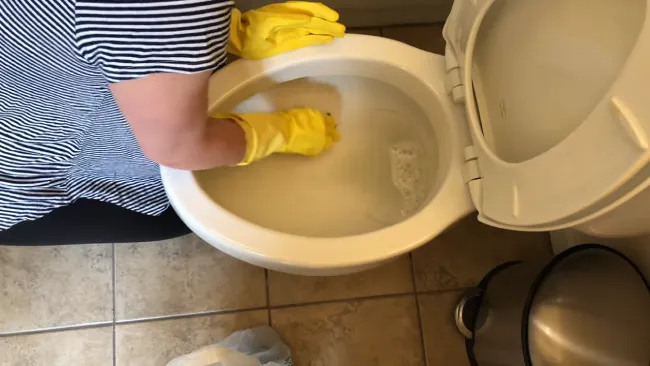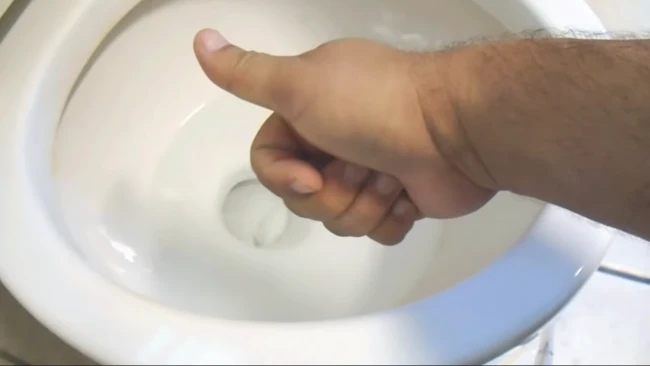Last Updated on October 16, 2023
Keeping Toilets clean is a real challenge, especially when faced with stubborn blue stains left by toilet cleaners. Not only do they make your toilet look unclean and unsanitary, but they also leave a lasting impression that is hard to ignore.
You can use various methods to remove these stains without having to replace the toilet bowl entirely. With the Denture Tablets Method, Oxygen Bleach, and Isopropyl Alcohol, you can get rid of those pesky blue stains and keep your toilet looking like new.
Discover the effective techniques for removing unsightly blue stains from your toilet with this insightful guide.
How to Remove Blue Stains From Toilet Bowl: 4 Methods

Several factors cause blue stains in toilet bowls, however, fret not, as effective methods are available to combat this common household dilemma. The severity of the stain determines the method to be employed.
Before Cleaning: Assess the Cleaning Product
Check the cleaning product to see if it contains any chemicals that could react with other cleaners before beginning the cleaning process. To ensure that mixing cleaning agents is safe, it is essential to do extensive research.
Chlorine bleach and other substances may interact and cause undesirable results if mixed, making it important to use caution when mixing them together.
Flushing multiple times may not remove all cleaner residue from inside the toilet bowl, so it is wise to use only one cleaner at a time to prevent unwanted reactions.
Now you can use the following cleaning methods:
Method 1: Denture Tablets
The Denture Tablets Method offers an efficient solution to remove stubborn dye discolorations from the interior of toilet bowls. To apply this method, drop multiple denture tablets into the bowl and let them dissolve. Using this process, the stain dissolves effectively.
It’s important to leave the tablets for sufficient time before scrubbing them with a brush or tool. If you wish to remove all stains completely, you may need to repeat this process.
This method is a safe and affordable alternative to harsh chemicals, making it a popular choice for many households.
Method 2: Oxygen Bleach
Oxygen bleach is also an effective way to eliminate discoloration from a toilet’s interior. To use this method, pour the oxygen bleach into the bowl and sprinkle some onto the toilet brush before scrubbing.
Scrub thoroughly with the brush and then let it sit for 20 minutes. Afterward, scrub briefly again and flush. This provides a deep clean that will remove any blue stains from the bowl without harsh chemicals or abrasive material.
Also, oxygen bleach is safe for toilets, allowing you to keep your bathrooms clean without damaging surfaces.
Method 3: Isopropyl Alcohol
Isopropyl alcohol can safely clean and disinfect a toilet, making it an easier alternative to harsh chemicals or abrasives.
To do this, pour approximately 1/4 cup of isopropyl alcohol into the toilet bowl and allow it to sit for about 20 minutes. After this time, scrub the bowl thoroughly to remove any blue stains.
It’s really handy for getting rid of mildew, other stubborn stains in the toilet bowl, and odors caused by bacteria buildup. If you want to keep your bathroom clean without breaking the bank, isopropyl alcohol is an ideal choice.
Method 4: Using Chlorine Bleach
As a bathroom sanitizer, chlorine bleach is a popular choice due to its ability to eliminate bacteria and odor-causing germs. When used with caution, it is safe to use chlorine bleach for cleaning toilet bowls.
Add a small splash (about a teaspoon) of chlorine bleach to the toilet bowl’s water to use the chlorine bleach method. Then, allow it to sit for at least 20 minutes. After this time has passed, scrubbing the bowl thoroughly is recommended before flushing.
If needed, repeat the process until all blue stains have been removed.
Please be aware of safety precautions when using this method since improper handling can cause skin irritation or respiratory problems.
Why does the toilet bowl have a blue stain?

Discoloration in the toilet bowl is caused by corrosion and dissolution of copper pipe and fittings. Usually, this happens when water interacts with copper, zinc, or brass metal components. It can cause the metal to dissolve into the water.
As these dissolved metals come in contact with the porcelain surface of the toilet bowl, they leave behind blue or green stains that are difficult to remove. The best way to prevent this staining is to replace corroded pipes or fittings with new ones made from corrosion-resistant materials.
Does hard water cause blue stains on the toilet bowl?
Hard water can lead to corrosion of metal components in the toilet bowl, resulting in discoloration on the porcelain surface. This is due to its high dissolved calcium and magnesium concentration, making it more acidic than soft water.
When hard water comes into contact with the metal parts of a toilet bowl, it corrodes them. As a result, blue stains form on the porcelain surface where they’ve been exposed to hard water for an extended period of time.
Regularly clean and maintain your toilet bowl so that these blue stains don’t build up over time and cause permanent damage.
Does detergent cause blue stains?

Detergents can cause discoloration on fabrics, leading to the formation of colored residues. In this case, blue stains may be caused by artificial dyes in detergent.
Even though you can remove these stains with warm water and pretreatment, you should still do it quickly. They will be set if left untreated for too long.
Identify the source of the stain before attempting to remove it. Blue detergent stains differ from those caused by hard water or other sources. Understanding what causes blue stains on toilet bowls can help prevent or remove them effectively.
Baffling Blue Stains in Toilets: The Culprits Revealed
The cause of blue stains in toilet bowls is uncertain and can vary from one location to the next. Hard water may be the culprit in some cases, while detergent residue may be responsible in others.
No matter the cause, removing the blue stains with a few simple steps is possible. The four methods detailed include using commercial cleaners, natural ingredients such as vinegar or baking soda, scrubbing with a brush and cleaning with bleach.
Each method has its own advantages and disadvantages, but all should be able to remove blue stains from a toilet bowl effectively. Ultimately, it comes down to personal preference regarding which method works best for each situation.

